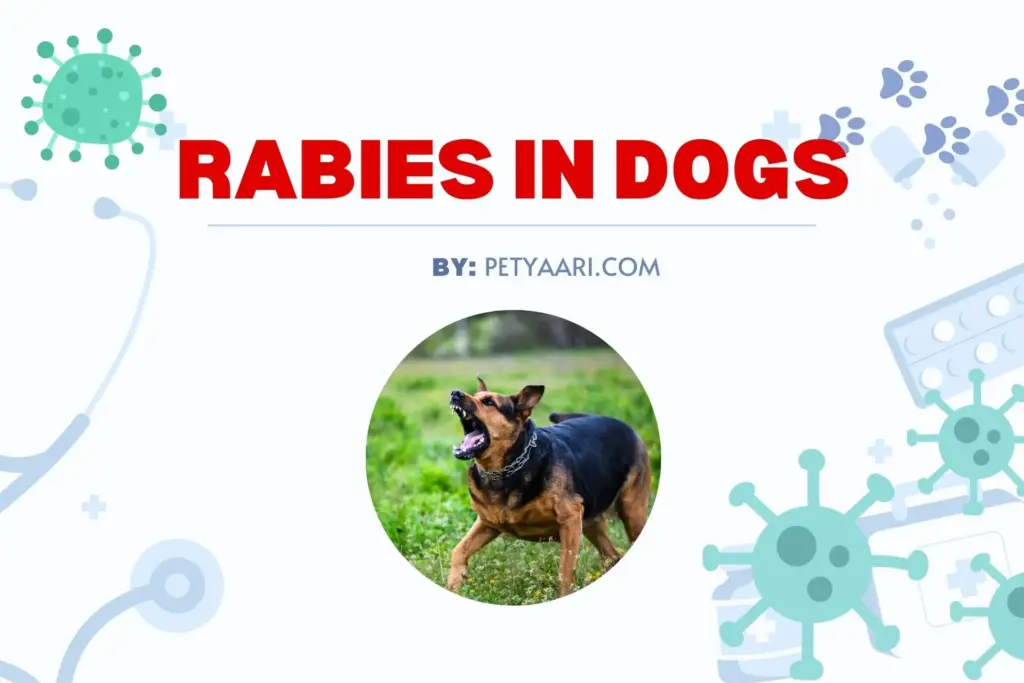Introduction
Rabies is a deadly viral disease that poses a significant threat to dogs and humans. In India, where stray dogs are a primary source of rabies transmission, understanding the disease is critical for pet owners and communities. The tragic story of a state-level Kabaddi player who died of rabies after dismissing a puppy’s bite as “nothing serious” highlights the devastating consequences of ignorance about this disease. This blog aims to educate dog owners about rabies, its symptoms, transmission, and prevention strategies, emphasizing the vital role of vaccination and responsible pet ownership, with a focus on how Petyaari Pet Clinic supports these efforts.
What is Rabies?
Rabies is a zoonotic viral disease caused by the rabies virus, a member of the Lyssavirus genus, which leads to fatal inflammation of the brain and spinal cord. It affects mammals, including dogs, cats, wildlife, and humans. It is nearly 100% fatal once symptoms appear. Historically, rabies has been a global scourge, with India accounting for 36% of the world’s 59,000 annual human rabies deaths, mainly due to unvaccinated stray dogs.
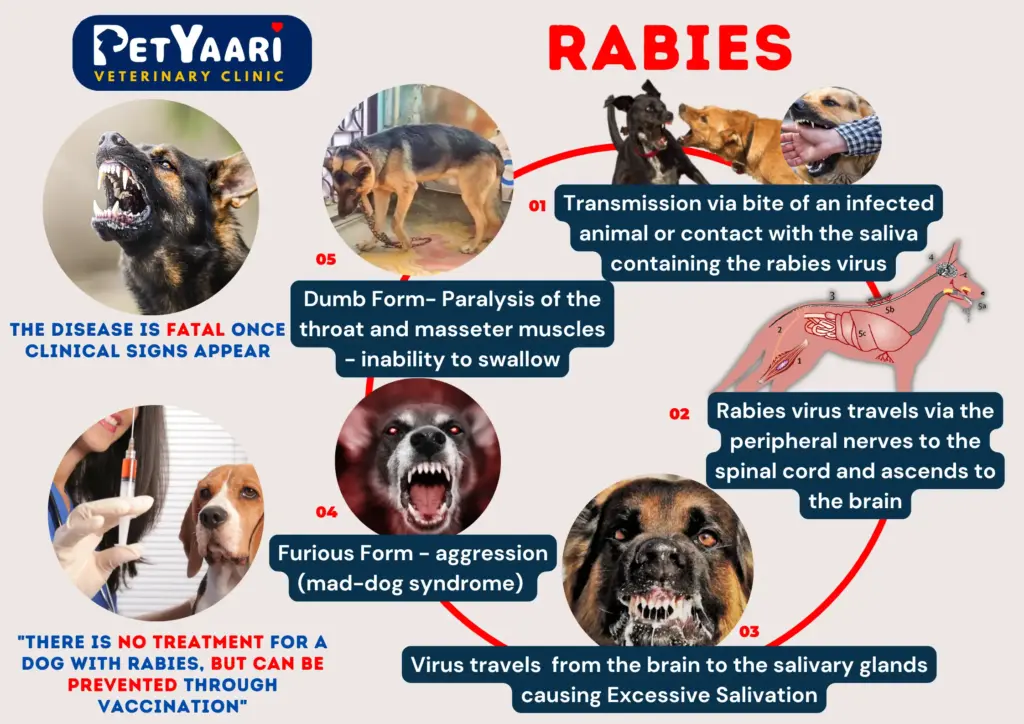
The rabies virus resides in the saliva of infected animals and primarily spreads through bites and scratches. It travels along nerves to the brain, causing severe neurological damage. In India, rabies remains endemic, with 18,000–20,000 human deaths annually, underscoring the urgency of awareness and prevention.
Symptoms of Rabies in Dogs
Rabies in dogs progresses through distinct stages, with symptoms varying from subtle to severe.
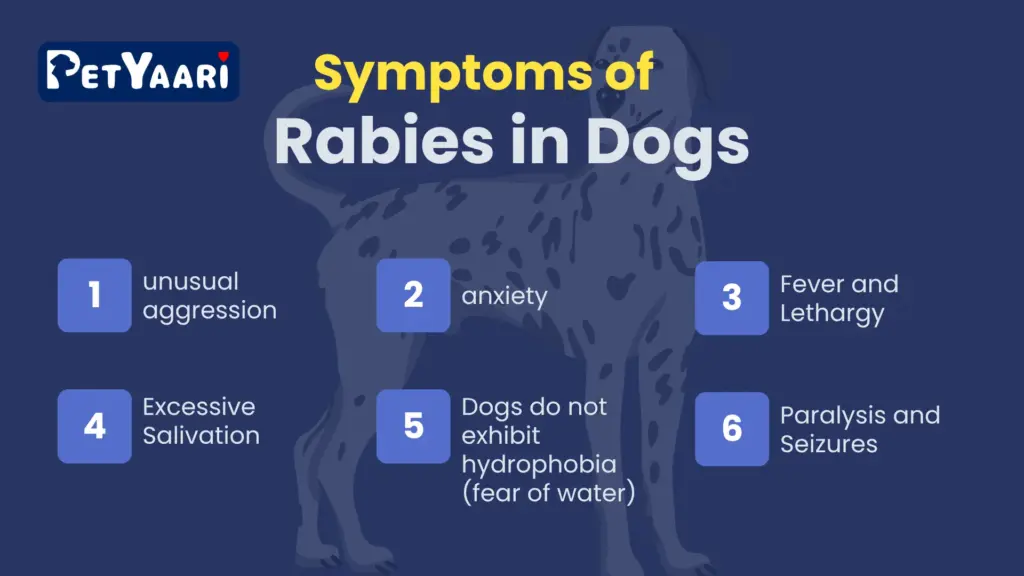
Early Clinical Signs
- Behavioural Changes: Dogs may exhibit unusual aggression, anxiety, or withdrawal. A friendly dog might snap unexpectedly, or a shy dog may seek attention.
- Fever and Lethargy: Initial symptoms include fever, reduced energy, and loss of appetite, which can often be mistaken for other illnesses.
Advanced Symptoms
- Aggression and Confusion: The “furious” form of rabies causes hyperactivity, disorientation, and unprovoked aggression, such as biting without reason.
- Difficulty Swallowing and Excessive Salivation: Dogs do not exhibit hydrophobia (fear of water) as humans, but choke while drinking, or drool excessively due to throat paralysis, leading to the classic “foaming at the mouth.“
- Paralysis and Seizures: In the “paralytic” or “dumb” form, dogs develop weakness, facial distortion, and paralysis, which typically starts in the hind legs and spreads. Seizures and coma follow, leading to death within days.
The incubation period in dogs typically ranges from two weeks to four months, though it can be as short as nine days.
Transmission of Rabies
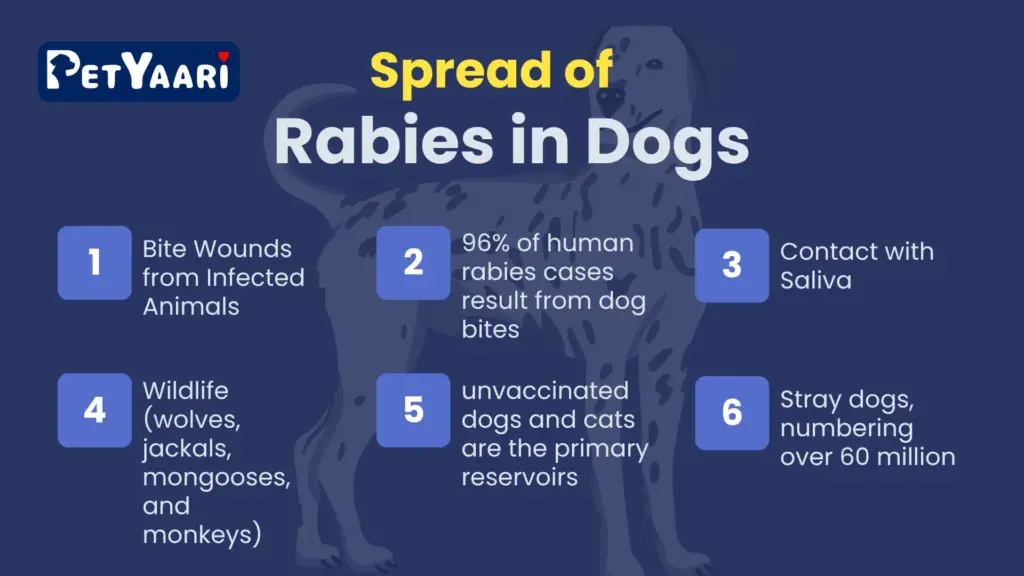
How the Virus Spreads
- Bite Wounds from Infected Animals: The primary mode of transmission is through bites, as the virus in saliva enters the bloodstream. In India, 96% of human rabies cases result from dog bites, particularly from strays.
- Contact with Saliva: Less commonly, rabies spreads when infected saliva comes into contact with open wounds, scratches, or mucous membranes (e.g., eyes, mouth). Licking from an infected animal can also pose a risk.
Common Carriers of Rabies
- Wildlife: In North America, bats, raccoons, skunks, and foxes are major carriers; however, in India, wildlife such as wolves, jackals, mongooses, and monkeys play a minor role. Rabies in bats is not conclusively reported in India.
- Domestic Animals: In India, unvaccinated dogs and cats are the primary reservoirs. Stray dogs, numbering over 60 million, are a significant public health concern due to limited vaccination coverage.
How to Prevent Rabies
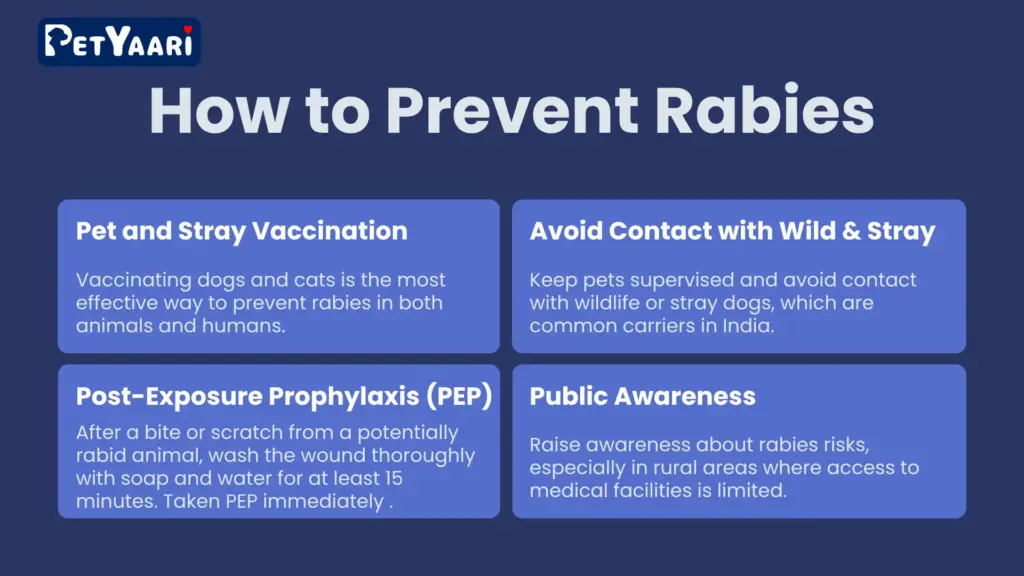
Rabies is 100% preventable through timely vaccination and awareness. Here are key prevention strategies:
1. Vaccinate Pets
- Pet Vaccination: Vaccinating dogs and cats is the most effective way to prevent rabies in both animals and humans. In India, rabies vaccines for pets are legally mandatory and cost approximately ₹350 per dose. Puppies and kittens should receive their first rabies vaccine at 12–14 weeks, with a booster 21–30 days later, followed by annual or triennial boosters depending on the vaccine (e.g., Nobivac 1-Rabies or Nobivac 3-Rabies).
- Stray Dog Vaccination: Mass vaccination of stray dogs, as promoted by organizations like Mission Rabies, reduces the risk of dog-mediated rabies. Oral rabies vaccines (ORV) are being explored to reach free-roaming dogs, increasing coverage and reducing costs.
- Legal Requirements: In many regions, including India and the U.S., rabies vaccination is required by law for dogs, cats, and ferrets over three months old.
2. Post-Exposure Prophylaxis (PEP)
- Immediate Action: After a bite or scratch from a potentially rabid animal, wash the wound thoroughly with soap and water for at least 15 minutes to reduce viral load. Seek medical attention immediately for PEP, which includes rabies immunoglobulin and a series of vaccines over 28 days.
- For Unvaccinated Pets: If an unvaccinated pet is bitten, it may need to be quarantined for four to six months or euthanized if rabies is suspected. Vaccinated pets exposed to rabies require a booster and a 45-day observation period.
3. Avoid Contact with Wild or Stray Animals
- Keep pets supervised and avoid contact with wildlife or stray dogs, which are common carriers in India. Do not attempt to handle or rescue stray animals without protective gear, as even well-meaning actions can lead to bites, as in the Kabaddi player’s case.
- Educate children to report animal bites immediately, as they are at higher risk due to unrecognized exposures.
4. Public Awareness
- Raise awareness about rabies risks, especially in rural areas where access to medical facilities is limited. Programs like World Rabies Day (September 28) promote education and vaccination drives.
- India’s National Rabies Control Programme (NRCP) offers a helpline (15400) for information on first aid, vaccination schedules, and nearby health facilities with anti-rabies vaccines and serum.
The Importance of Rabies Vaccination
Overview of Rabies Vaccination
Rabies vaccines are highly effective in preventing infection in dogs and protecting humans. Vaccines like Nobivac, Rabigen, and Zoetis Defensor stimulate the immune system, further preventing the virus from spreading if a vaccinated dog is bitten.
Vaccination Schedule for Dogs
- Puppies: Receive their first rabies vaccine at 12–14 weeks, followed by a booster 21–30 days later.
- Adult Dogs: Require annual boosters or triennial boosters (e.g., Nobivac 3-Rabies), depending on the vaccine and local regulations.
- Cost: In India, a single dose costs approximately ₹350, making it accessible for most pet owners.
Dog Bite Vaccine and Schedule
The term dog bite vaccine often refers to the anti-rabies vaccine for dogs given post-exposure (post-bite) or as preventive care. If an unvaccinated animal bites your dog:
- Unvaccinated Dogs Require immediate vaccination with five doses scheduled on days 0, 3, 7, 14, and 28, and a 4-month quarantine.
- Vaccinated Dogs: May need a booster and 10-day observation, as vaccine failures are rare but possible.
The dog bite vaccine schedule for post-exposure prophylaxis (PEP) in humans follows WHO guidelines: 5 doses on days 0, 3, 7, 14, and 28.
Legal Requirements and Regulations
In India, rabies vaccination is mandatory for dogs and cats over three months old. Many states require proof of immunization for licensing, travel, or boarding. Unvaccinated dogs exposed to rabies may face quarantine (four to six months) or euthanasia.
Responsible Pet Ownership
Keeping Dogs Safe from Exposure
- Avoid letting dogs roam freely, as they may encounter infected strays or wildlife.
- Secure yards and use leashes during walks to prevent interactions with unknown animals.
Importance of Leash Laws and Supervision
- Adhering to leash laws reduces the risk of bites and exposure to rabies. Supervise dogs in public spaces, especially in areas with stray populations.
Spaying and Neutering to Control Stray Populations
- Spaying and neutering pets, as well as supporting sterilisation programs for strays, reduces the number of unvaccinated dogs and is a key factor in India’s rabies burden. Programs like Mission Rabies combine sterilization with vaccination to curb transmission.
Signs of Rabies in Other Animals
Recognising Rabies in Wildlife
- Behavioural Changes: Wild animals, such as jackals or monkeys, may appear tame, approach humans, or exhibit aggression.
- Physical Signs: Look for staggering, drooling, or paralysis. Nocturnal animals active during the day (e.g., bats) may indicate rabies.
Implications for Dogs Interacting with Other Animals
Dogs that chase or come into contact with wildlife risk exposure. Pet owners should discourage such interactions and ensure vaccinations are up to date to protect against potential encounters.
What to Do If You Suspect Rabies
Immediate Actions to Take
- For Humans: Wash any bite or scratch with soap and water for 15 minutes to reduce viral load. Seek medical attention immediately for post-exposure prophylaxis (PEP), which includes rabies immunoglobulin and a series of vaccines.
- For Pets: Isolate the dog and contact a veterinarian. Do not handle the animal without gloves if rabies is suspected.
Contacting a Veterinarian
- A vet will assess the dog’s vaccination status and symptoms. Vaccinated dogs may need a booster and a 45-day observation period; unvaccinated dogs may require quarantine or euthanasia.
Reporting to Local Health Authorities
- In India, report suspected rabies cases to local health departments or the National Rabies Control Programme (NRCP) helpline (15400). This ensures the monitoring and containment of outbreaks.
Rabies Vaccination at Petyaari Pet Clinic
Overview of Services Offered
Petyaari Pet Clinic, with branches in Hyderabad (e.g., Kharmanghat, BN Reddy Nagar, Vanastalipuram), offers affordable rabies vaccinations (₹350 per dose) using trusted brands like Nobivac and Rabigen. They provide comprehensive pet care, including deworming, to enhance vaccine efficacy.
Affordable and Accessible Vaccinations
- Petyaari offers rabies vaccines for dogs and cats at approximately ₹350 per dose, making it affordable for pet parents. They use trusted brands like Nobivac, Rabigen, and Zoetis Defensor, ensuring high efficacy.
- The clinic follows a strict vaccination schedule: puppies receive their first rabies shot at 12–14 weeks, with a booster 21–30 days later, and annual or triennial boosters thereafter. Kittens follow a similar protocol.
Importance of Regular Check-Ups and Vaccinations
- Petyaari’s veterinarians conduct regular health checks to ensure pets are fit for vaccination. They offer digital vaccination records and automated reminders via SMS or email for booster shots.
- The clinic supports stray dog vaccination drives in collaboration with NGOs, contributing to India’s goal of eliminating dog-mediated rabies by 2030.
Expert Veterinary Care
- Petyaari’s veterinarians are trained to educate pet owners about rabies risks and the importance of timely vaccinations. They provide post-exposure guidance, ensuring pets and humans receive prompt care after potential exposures.
Client Testimonials and Success Stories
- “Petyaari’s vaccination program saved my dog from a stray bite. Their reminders keep us on track!” – Priya, Hyderabad.
- “Their affordable vaccines and expert advice gave us peace of mind. My puppy is healthy and protected.” – Anil, Vanastalipuram.
- Petyaari’s community outreach has vaccinated thousands of strays, reducing local rabies risks and earning trust among pet owners.
Lessons from the Tragedy
The Kabaddi player’s death is a sobering reminder of the consequences of underestimating rabies. His compassionate act of rescuing a puppy, while noble, led to a fatal outcome due to a lack of immediate action. This tragedy highlights several key lessons:
- No Bite is Too Small: Even minor bites or scratches can transmit rabies. Always seek medical attention and consider PEP after any animal bite.
- Vaccination is Non-Negotiable: Pet owners must vaccinate their dogs and cats, and communities should support stray dog vaccination programs to reduce rabies reservoirs.
- Awareness Saves Lives: Public education about rabies risks and prevention can prevent tragedies, especially in high-risk areas like India.
FAQs
Do squirrels have rabies?
Squirrels can theoretically carry rabies, but it is extremely rare. Small rodents like squirrels, mice, and hamsters are not primary reservoirs for the rabies virus. In India, dogs (especially strays) are the main carriers, responsible for 96% of human rabies cases. If bitten by a squirrel, wash the wound thoroughly with soap and water for 15 minutes and consult a doctor to assess the need for post-exposure prophylaxis (PEP).
Do rats carry rabies?
Rats, like squirrels, are not significant carriers of rabies. The virus is primarily transmitted by larger mammals, such as dogs, cats, wolves, jackals, and mongooses in India. Rat bites are more likely to cause bacterial infections like rat bite fever than rabies. However, any bite should be cleaned immediately, and consult a doctor for medical advice.
Can rabies be transmitted through kissing?
Rabies cannot be transmitted through casual kissing, such as a peck on the cheek, unless infected saliva from an animal or person with rabies contacts an open wound or mucous membranes (e.g., mouth, eyes). Deep kissing with an infected person who has rabies virus in their saliva is theoretically possible, but extremely rare. The primary mode of transmission is through animal bites.
Are there rabies-free zones in India?
India has no officially designated rabies-free zones, as the disease is endemic, particularly due to the large population of unvaccinated stray dogs. However, regions like the Andaman and Nicobar Islands and Lakshadweep have lower rabies incidence due to their isolation and smaller stray dog populations. Efforts under the National Rabies Control Programme (NRCP) aim to reduce cases to eliminate dog-mediated rabies by 2030.
What is the name of the rabies test?
Rabies in animals is typically diagnosed post-mortem using the Fluorescent Antibody Test (FAT) on brain tissue, considered the gold standard. For living animals, tests like the RT-PCR (Reverse Transcription Polymerase Chain Reaction) can detect viral RNA in saliva or cerebrospinal fluid, but these are less common. In humans, diagnosis during life involves tests like skin biopsy, saliva PCR, or serum antibody tests, but these are complex and usually performed only in specialised labs. If you suspect rabies exposure, consult a doctor immediately rather than waiting for testing.
Can a cat scratch cause rabies?
A cat scratch can transmit rabies if the cat’s claws carry infected saliva (e.g., from grooming) and the scratch breaks the skin. While less common than bites, scratches from potentially rabid cats should be treated seriously. Wash the wound with soap and water for 15 minutes and seek medical attention for PEP evaluation.
Is there a rabies vaccine for cats?
Yes, rabies vaccines are available for cats and are highly effective. In India, vaccines like Nobivac Rabies or Rabigen are used, costing around ₹350 per dose. Cats should receive their first vaccine at 12–14 weeks, followed by a booster 21–30 days later, and annual or triennial boosters thereafter. Petyaari Pet Clinic offers these vaccinations with digital records and reminders to ensure compliance.
Can a vaccinated dog get rabies?
A properly vaccinated dog is highly unlikely to get rabies, as vaccines are nearly 100% effective when administered correctly and boosters are maintained. However, rare cases can occur if the vaccine fails (e.g., improper storage, compromised immune system). If a vaccinated dog is bitten by a potentially rabid animal, it requires a booster shot and a 45-day observation period.
What is the dose for Rabipur injection?
Rabipur, a rabies vaccine used for humans, is administered as part of post-exposure prophylaxis (PEP) or pre-exposure prophylaxis (PrEP). For PEP, the standard regimen is:
Intramuscular (IM): 1 mL per dose on days 0, 3, 7, 14, and sometimes 28, depending on the protocol.
Intradermal (ID): 0.1 mL per site, with two sites injected on days 0, 3, 7, and 28 (WHO-approved for cost-effectiveness in India). For PrEP, three 1 mL IM doses or 0.1 mL ID doses are given on days 0, 7, and 21 or 28. Always consult a healthcare provider before vaccination.
How long does the rabies vaccine last?
At Petyaari Pet Clinic, veterinarians recommend annual boosters for maximum protection. In humans, PrEP provides immunity for several years, but boosters are needed after exposure. PEP is effective only if given before symptoms appear.
Can a dog scratch cause rabies?
A dog scratch can transmit rabies if the dog’s claws carry infected saliva and the scratch breaks the skin, though this is rare compared to bites. Wash the scratch thoroughly with soap and water for 15 minutes and consult a doctor to assess the need for PEP.
What is the first aid for a rat bite?
While rat bites rarely transmit rabies, they can cause infections. First aid includes:
Wash the wound with soap and running water for 15 minutes.
Apply an antiseptic (e.g., povidone-iodine).
Cover with a clean bandage.
Seek medical attention to evaluate for bacterial infections (e.g., rat-bite fever) or, in rare cases, rabies PEP if the rat shows unusual behaviour (e.g., aggression, staggering).
How long is the anti-rabies vaccine effective in humans?
For humans, pre-exposure prophylaxis (PrEP) provides immunity for several years, but its duration varies based on exposure risk. High-risk individuals (e.g., veterinarians) may need boosters every 1–3 years. Post-exposure prophylaxis (PEP) is effective only if administered before symptoms appear, typically within hours to days of a bite. Immunity from PEP reduces over time, requiring boosters if re-exposed.
Is rabies curable?
Rabies is not curable once clinical symptoms appear, with a near 100% fatality rate. However, it is 100% preventable with timely PEP, which includes wound cleaning, rabies immunoglobulin, and a series of vaccines. The Kabaddi player’s death underscores the importance of seeking PEP immediately after a bite, as he dismissed the injury and missed this critical window.
Can rabies spread from person to person?
Person-to-person transmission of rabies is extremely rare and typically occurs only through organ transplantation or, theoretically, via infected saliva contacting mucous membranes or open wounds. Casual contact, such as touching or hugging, does not spread rabies. The primary concern remains animal-to-human transmission via bites.
Do all dogs have rabies?
No, not all dogs have rabies. However, unvaccinated dogs, especially strays, are at higher risk of carrying and transmitting the virus. In India, the large stray dog population (over 60 million) contributes to the high rabies burden. Vaccinating pet dogs and supporting stray vaccination programs, like those backed by Petyaari Pet Clinic and Mission Rabies, significantly reduces this risk.
Conclusion
Rabies is a 100% preventable but deadly disease that requires vigilance from pet owners. By understanding the symptoms, transmission, and prevention strategies, dog owners can protect their pets and the communities they live in. Vaccinations, responsible pet ownership, and prompt action after potential exposure are critical to combatting rabies. Petyaari Pet Clinic plays a pivotal role by offering affordable vaccinations, expert care, and community outreach. The Kabaddi player’s tragic death underlines the stakes: no bite is too small to ignore. Schedule your dog’s rabies vaccine today, support stray vaccination programs, and stay informed to keep rabies at Conness
Visit Petyaari Pet Clinic or contact the NRCP helpline (15400) for vaccination and guidance. Together, we can make India rabies-free by 2030.
